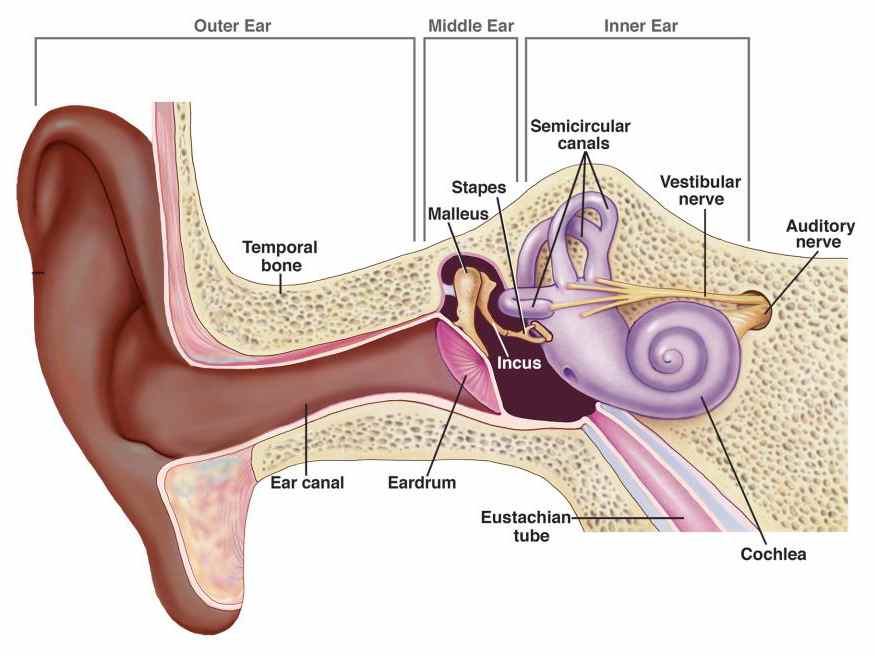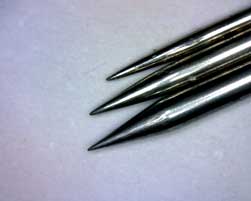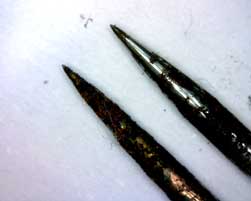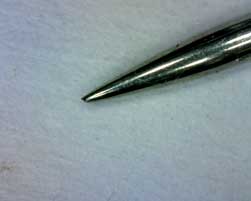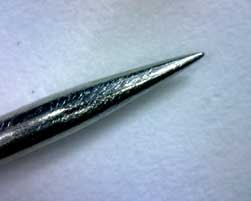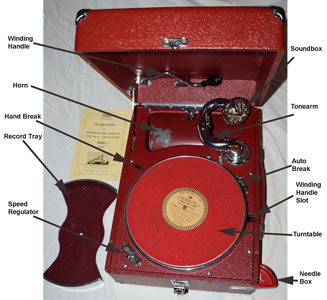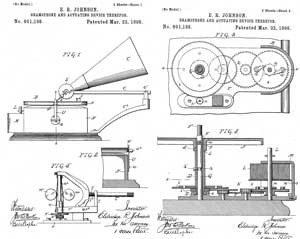Phonographs and Gramophones for beginners
This FAQ section covers the basics of collecting gramophones and phonographs. A simplified history, how sound is recorded and reproduced, the terms used and how to spot authentic machines from fake ones.
HISTORY:
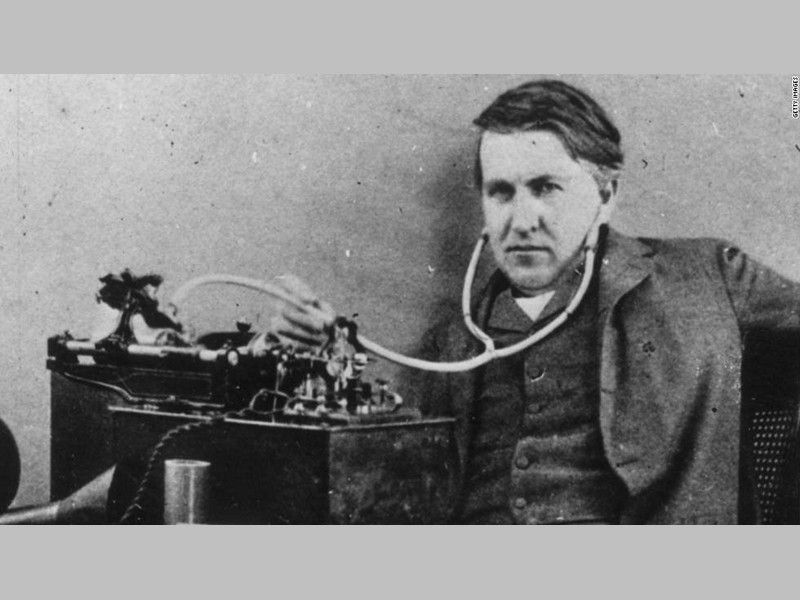
THOMAS EDISON invented the PHONOGRAPH in 1877. A device for recording and reproducing sound. It was a hand-wound cylinder drum covered in tinfoil that was inscribed by a needle fitted to the centre of a diaphragm, which in turn was fitted to a small horn. He envisioned a dictating machine.
In 1886 CHARLES TAINTER and CHICHESTER BELL improved the quality of reproduction by introducing the GRAPHOPHONE which used wax cylinders. Edison followed suit and in 1888 issued the "Perfected Phonograph" which played 2 minutes of sound. Commercial pre-recorded cylinders followed and the recording industry was born. In 1912 Edison introduced the Blue Amberol Cylinders that were made of celluloid and played for 4 minutes. The last commercial cylinders were phased out in 1929.
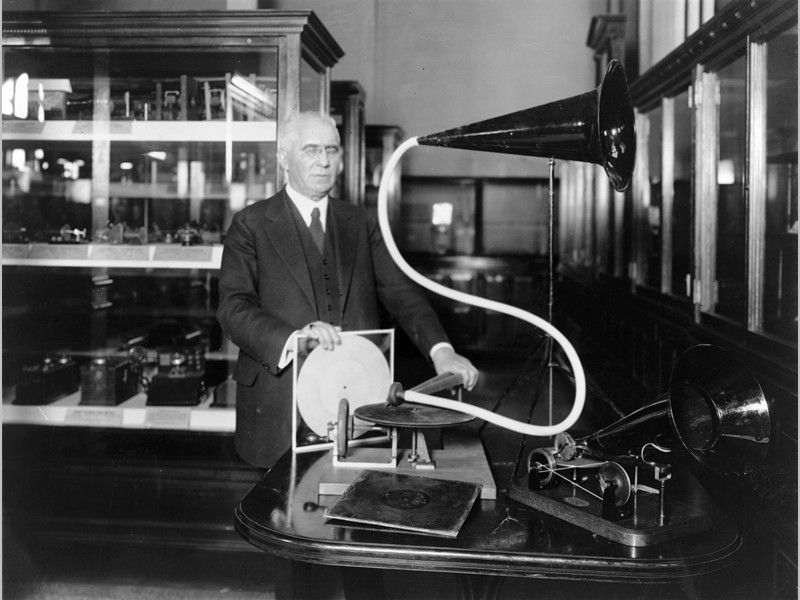
EMILE BERLINER first patented the GRAMOPHONE and Flat Disc Record in the USA in 1887.
The gramophone was first sold in Germany by a toy manufacturer, the records were made from chocolate. In the USA, Berliner joined forces with ELDRIDGE JOHNSON who introduced a reliable spring motor. Due to legal problems, Berliner was forced to move to Canada and started the Berliner Gram-O-Phone Company
In the US, the VICTOR Talking Machine Company was founded in 1901 by Eldridge Johnson and the name "Gramophone" was abandoned. He registered his company's trademark - Francis Barraud's image of his dog, Nipper, listening to his master's voice. The UK equivalent became HMV.
HOW IT WORKS:
The basic principles of how sound is recorded and played back.
- Sound recording and reproduction are directly related to how our ears work. The "Diaphragm" replicated the eardrum membrane and the "stylus bar, chuck and needle" try and replicate the three tiniest bones in the "middle ear".
- Sound travels in invisible vibrations, sound waves. Each sound wave frequency has a precise sound.
- Sound recording is the transcription of these vibrations in the air onto a storage medium like a record disc. The process is reversed in sound reproduction, and the variations stored on the disc are transformed back into sound waves.
- Analog recording is when a diaphragm that senses changes in atmospheric pressure caused by acoustic sound waves, records them as a mechanical image of the sound waves and using a cutting stylus, cuts grooves on a soft master record.
- Through a process of electroplating, a hard stamper was made from the soft master. Basically a hard reverse mold of the soft master.
- On a phonograph, the sound waves are stored on wax cylinders in a "Hill & Dale" process, vertical recordings. That is, the stylus cuts into the wax in an up and down motion as the cylinder is rotated at a set speed while cutting a spiral pattern into the wax. When another playback stylus attached to a diaphragm is placed back in the recorded groove and played back at the same speed as it was recorded, the diaphragm again moves the air and reproduces the same sound back through an amplifying horn.
- On a gramophone, the sound waves are recorded in a "lateral" pattern, that is, the stylus moves from side to side instead of up and down.
- The gramophone record became the standard over the cylinder as the cylinder records were a lot more difficult and more expensive to mass produce. A mold had to be made of the wax master cylinder and then each cylinder had to be molded inside that master. On cooling, it shrank just enough to be removed from the mold. The flat disc record on the other hand required two flat masters which were used as stampers. The softened medium of shellac and later vinyl was easily stamped by the masters in their millions.
- Crackle, click, pop, hiss, wow and flutter. Those noisy records! Records, being a physical medium and the physical contact with a needle in a groove is going to make noise. Records get scratched, warp, collect dust and are generally filthy things. Keeping them clean and static free is a constant battle. Then there are recording and manufacturing defects, off-centre holes, bad inner sleeves, poor pressings and the list goes on and on.......
- Why do we bother? Well there is nothing quite like listening to an analogue recording, especially a live recording where you can actually sense the artist in the room, even with the pops and crackles. Caruso may have died over a hundred years ago, but he is still full of life, right here in my living room, belting it out from my gramophone. Immortality.
TERMINOLOGY:
- PHONOGRAPH: In the USA the term Phonograph has become a generic term for cylinder and disc machines.
- GRAMOPHONE: Is used in Europe for flat disc machines. Whereas, Phonograph is exclusively used for any cylinder machine.
- REPRODUCER: The term used mainly in the USA to describe the device that makes contact with the record or cylinder. This consists of a diaphragm made from mica or aluminium. A stylus or needle bar is attached to the diaphragm and enclosed in a housing.
- METAL NEEDLES: Some old needle tins may contain brass or copper needles but most and the best needles are made from soft steel. The needle wears out not the record. That is why you only use one needle per side and then you throw it away. If you don't, the worn out needle becomes a chisel and starts to literally cut up your records destroying them for good. Some are made from harder metals and claim to be "multi-play" needles, I avoid these as they will ruin your precious records. New needles from a good supplier are cheap. Always check your supply of needles, even new and NOS needles can be awful. Check under a magnifying glass. They should be smooth and polished. Some "new" needles are not polished and again will ruin your records. I buy them "New Made" on Ebay from Europe in batches of 2500, make sure they are highly polished.
- FIBRE NEEDLES: Mostly made from triangular bamboo but also round fibre thorns. These are used by gramophiles and need to be played on gramophones that have good tracking otherwise the tips break or wear out before one side is played. Fibre needles are usually treated chemically to harden them through a process called "doping".
- TRACKING: As the tonearm tracks across the record there is always a tracking error from the beginning of the record to the end of the record. The goal is to minimise this error so there is equal pressure of the needle in the groove walls. Good tracking means less distortion and less wear on the record. Most pre-orthophonic (1927) gramophones have terrible tracking and will most probably ruin your records. Firstly, tracking is governed by the exact scientific positioning of the tonearm in relation to the turntable. Then there is the angle of the soundbox on the tonearm. Pretty much the same problems facing modern turntables with tracking and anti-skating.
- SOUNDBOX: The term used in Europe to describe a reproducer
- TONEARM: The tonearm connects the soundbox to an amplifying horn. It also allows the soundbox to track the recorded grooves in the record with minimal friction.
- TURNTABLE: The metal platter usually covered in felt that holds and spins the record.
- SHELLAC records: Came in various diameters from 6" to 20". The standard was set at 10" and 12". Early records were recorded at 60-130 RPM speeds. By 1925 most companies were standardized to 78rpm. Shellac is a resin secreted by the female Lac Beetle on trees in the forests of India, Malaysia and Thailand. It is processed and sold as dry flakes and dissolves in alcohol to make liquid shellac which is used in polishing furniture (French Polish). It was the main ingredient in 78rpm shellac records until 1948 when it was replaced by vinyl.
- CYLINDER records: Various sizes and diameters were made. Early cylinders rotated at 90 to 125 rpm, By 1902 the standard was 160 rpm. They were originally made from wax that played for 2 minutes. Then came the 4 minute wax cylinder which was quickly replaced by a celluloid cylinder record.
- DIAMOND Discs: (1912-1929) Edison Diamond Discs were Edison's attempt to make a flat disc. These were 6mm thick and still vertical cut like cylinders. They used a permanent conical diamond stylus for playing them. You CANNOT play these on a "normal" gramophones which plays lateral records. Adaptors were made that allowed for Lateral records to be played on Edison machines and vice versa.
- HILL & DALE (Vertical cut records): All cylinder records, Edison and others. Edison Diamond Discs and some European flat-disc records, most notably by Pathé.
- LATERAL cut records: Most flat disc records.
- SPRING motors: Eldridge Johnson introduced the wind-up spring motor to the gramophone which made them affordable and portable. Some massive 4-spring motors can play for half an hour.
- ELECTRIC motors: Edison's "Improved Phonograph" used an electric motor making it unaffordable to most. Electric motors started becoming cheaper in 1930.
- EXTERNAL HORN Gramophones: Most gramophones pre-1927 had metal or wooden external horns.
- INTERNAL HORN Gramophones: These were introduced around 1906 and by 1927 most gramophones were built with their horns hidden in cabinets. External horns were considered "vulgar". Except for EMG and EXPERT in England of course.
- ORTHOPHONIC Gramophones: (1926-1932). Made by Victor in the USA and HMV in Europe. These were scientifically designed gramophones that were the best sounding acoustic gramophones made before Electric gramophones took over. The tracking tonearm was much improved and a 9 feet exponential horn was "folding" into a large cabinet.
SPOTTING FAKES
Unfortunately, fake gramophones are far too common and many people are duped into buying them thinking they are original. Trying to point this out to someone that has spent a small fortune on a fake and has had it for years, if not decades, can be challenging.
I personally have nothing against these fakes as long as the buyer is not being conned into thinking it is an original gramophone.
It infuriates me more when these fakes appear in period movies. It's just plain laziness.
Fortunately, most fakes are very easy to spot. Here are some terms and links that will help you spot a fake.
- CRAPOPHONES: These are often made in India and China. Often they will have a windup motor marked THORENS. I've been told without proof that a shipload of Swiss made Thorens motors ended up in India in the 1940's. The motors are often authentic but were made for suitcase gramophones (Portables). It's often the only real part. The rest really is crap...
- FRANKENPHONE: These are more difficult to spot but they are usually assembled in Europe and at least some of the parts are original but as the term suggests, they are put together from various parts that once belonged to other machines and together they create a monster.
- All of these fakes will ruin your records. Only play worn out records you don't care about on these machines.
- I am contacted regularly by people who want me to identify their gramophone. Usually it's a fake and it's the last thing they want to hear.
- Here are two great sites that will show you how to spot a Crapophone and avoid being duped. OLDCRANK AND The Gramophone Collector
